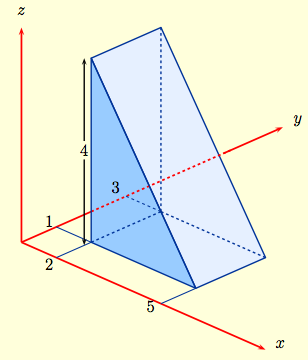Main page
Chapter 10: Parametric Equations and Polar Coordinates
Chapter 12: Vectors and the Geometry of Space
Chapter 13: Vector Functions
Chapter 14: Partial Derivatives
Chapter 15: Multiple Integrals
Learning module LM 15.1: Multiple integrals
BackgroundWhat is a double integral?
Volumes are double integrals
Learning module LM 15.2: Multiple integrals over rectangles:
Learning module LM 15.3: Double integrals over general regions:
Learning module LM 15.4: Double integrals in polar coordinates:
Learning module LM 15.5a: Multiple integrals in physics:
Learning module LM 15.5b: Integrals in probability and statistics:
Learning module LM 15.10: Change of variables:
Volumes are double integrals
Double integrals can be viewed as volumes in the same way that we view regular integrals as areas. This cuts two ways. We can compute volumes by doing double integrals. We can also understand double integrals by using what we already know about 3-dimensional geometry!
| For $z=f(x,\,y) \ge 0$ and $R$ is a rectangle in the $xy$-plane, then the Double Integral $$ \int\int_R\, f(x,\,y)\, dx dy $$ of $f$ over $R$ equals the volume of the solid under the graph of $f$ and above $R$. |
|
Example: Compute the integral
$\iint_R \frac{4}{3}(5-x) dA$, where $R$ is the rectangle
$[2,\,5]\,\times\,[1,\, 3]$ in the $xy$-plane.
Solution: The integral is equal to the volume of the solid $W$ shown to the right, namely the region between the $x$-$y$ plane and the plane $z=\frac{4}{3}(5-x)$ and above $R$. To find its volume, take a vertical slice for fixed $y, \, 1 \le y \le 3$. The trace of the solid on the vertical plane is the same triangle for each $y$. But the triangle has height $=4$ and base $=3$, so it has area $$\frac{1}{2}\times \hbox{base}\times \hbox{height} \ = \ 6\,.$$ Thus $W$ has $$\hbox{volume} = \hbox{area triangle}\times \hbox{side-length} = 12, \qquad \hbox{and}$$ $$\iint_R \frac{4}{3}(5-x) dA = \hbox{ volume of $W$ } = 12.$$ |
|
